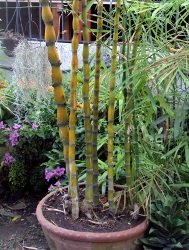The buddha belly bamboo (Bambusa ventricosa) naturally produces big seeds, with sizes similar to thorny bamboo or kawayan tinik (Bambusa blumeana), bayog ( Bambusa sp.) And botong (Gigantochloa levis).
These plant species are among those recommended for growing bamboo to mitigate global warming and for commercial purposes.
But with little effort and patience, you can produce a dwarf clump which is ideal as a bamboo bonsai and as a landscape specimen.

I first learned about bamboo bonsai from an old printed publication. It said that to produce a dwarf bamboo, the leaf sheaths which cover the growing culm should be regularly removed.
I tried applying the technique, but I failed.
I guess I was then too impatient because I stopped experimenting.
Then came the unexpected bonus. I happened to be home to a hedge or dwarf buddha’s belly in front.
The maximum height of the plants was about 1 meter. A few days later, I went back and bought some offsets.
Unexpectedly, I received an additional bonus.
The owner was so accommodating that he taught me how to maintain the short stature of my buddha belly bamboo.
So what do we do with other tall buddha belly dwarfs?
Easy. Just remove the flag leaf from the shoot once it reaches a height to your liking.
Do this regularly. The flag leaf is the uppermost, unopened leaf of the plant.
Tighten your fingers on that leaf at the top, then pull upward. I shouldn’t be worried, the plant will not die.
If it does, it’s for another reason. Instead, it will promote the growth of branches.
Being a grass, that is, being a member of the family Gramineae or Poaceae under Monocots, it is expected that the bamboo plant will regenerate a new terminal shoot.
With each removal of the uppermost leaf, the bud on top will develop into a branch that, due to apical dominance, will grow straight upward. It is imperative, therefore, that flag leaf removal is continued periodically.
Flag leaf removal will also induce the development of other branches.
To curtail their sideward extension, the technique of removing the leaves at the tip should likewise be done to these branches.
With time, you will have a buddha belly bamboo that grows from the ground or in a pot that is not only dwarf but also has proportionately short branches.
To start, of course, you need to plant a buddha belly.
One which has been separated from a dwarf clump will save plenty of time and effort in otherwise transforming it into the desired height.
Still, a tall bamboo can be cut back and you can then shift your attention to the new shoots that will emerge from the ground.
You may also propagate your bamboo with other methods like marcotting and rooting of culm cuttings.
To grow as bonsai, plant in a suitable pot or container and provide the necessary bonsai plant care.
Plant care essentially includes frequent watering, fertilizer application, and control of pests, particularly the mealy bugs.
